My first footsteps in Europe were in the airport in Venice. It was in 2007, when I was a sophomore in high school, some time before my sixteenth birthday. Typical of that age, I was awkward, hormonal, pubescent, immature. During this trip, I was exposed to the most beautiful things that I had ever seen, and was largely unimpressed. Teenagers are too wrapped up in themselves to care much for the outside world. I had a digital camera that my mom had lent me; but over half of the photos I brought back from the trip are of my friends, or cats, or other nonsense. The only thing that roused me to enthusiasm was the food, which was quite excellent.
Eleven years later, I finally returned to the city, to see what I had missed. It was quite a lot.


As usual, I was travelling on a budget. This pretty much ruled out the possibility of staying on the island of Venice itself. Small, antique, and exclusively devoted to tourism, accommodations are not cheap. Thankfully, there is the Mestre—the mainland of Venice (not the old city), which is generally quite a bit more reasonably priced. I stayed at an Airbnb in a quiet neighborhood and very much enjoyed the experience.
Frankly, I think staying in Mestre was better than staying in Venice itself, partly because I could get away from the crowds at night. And unlike the island of Venice, this quiet neighborhood had a real community of locals, which certainly improved the atmosphere. I had some beautiful mornings sipping coffee at a corner café, while I watched senior citizens come in for their morning glass of wine. And being close to affordable restaurants and supermarkets was also quite nice.
My memories of my first day in Venice, in 2007, are all a blur. We arrived early in the morning, all of us disoriented and jetlagged. Our hotel was right in the city center. Since virtually all of the buildings on the island are old, the rooms were tiny and the elevator only fit for one or two people. Most amusingly, our bathroom fan made a screeching, wailing noise that I will never forget. All of us badly wanted to take a nap, but our Irish tour guide insisted that we stay awake all day in order to adjust to the jet lag. By the time we had dinner, kids were falling asleep at the table. I nearly did the same.
Coming from Spain, at least I did not have to deal with jet lag this time.
The Mestre is very well connected to the city center with public transportation. In my case, all I needed was about a twenty-minute bus ride. Soon I arrived at the train station, stepped off, and confronted the new but strangely familiar profile of Venice.
Now, I have called the center of Venice “an island,” but that is not accurate. Rather, it is a collection of small islands—over 100—which are connected with bridges. The city occupies a lagoon between two rivers. This oddity of location is what gives the city its charm. Though Amsterdam and even New York may have more individual bridges, no city I know of is more dominated by the presence of water. But of course, having a city built on a lagoon entails unique challenges. The foundation of the city has been sinking, partly as a result of settling, and partly as a result of pumping groundwater (causing buildings to sink further into the ground). This, combined with climate change-induced rises in sea-levels, have worsened the periodic floods suffered by the city. Already, many ground floors are uninhabitable.
(In 2003, a massive engineering project was initiated, called MOSE, but it stalled because so much money had been siphoned off due to corruption. Work seems underway again, as global warming exacerbates the flooding problem. The flooding in 2019 was the worst in fifty years, causing widespread damage to the city’s cultural heritage.)
Building a city on a lagoon also entails unique transportation challenges. The lagoon is far too unstable for a subway, and the city is too cramped for either trains or buses; so the only option within the old center is by boat. The Venetian equivalent to a bus is the vaporetto, or water taxi, fair sized ferries that patrol the city in 19 lines. Line 1 is popular with tourists, since it goes down the Grand Canal. The other famous option for water transport is the gondola—operated by a single gondolier, pushing the elegant boat through the water with an oar. Nowadays the gondola exists exclusively for tourists, and the price reflects that: 80 euros for about half an hour, and more at night.

As I walked through the city, I have to admit that my first impressions were rather mixed. Venice is obviously and undeniably beautiful; indeed, judged purely in terms of its buildings, I believe it has a claim to being the most beautiful city in Europe. But the atmosphere of Venice is odd and empty. Keep in mind that I was visiting during the high tourist season, in July, when many locals go on holiday (about 55,000 live in the old center). This meant that whatever local life that Venice may have was largely dead. Instead, the streets were dominated by people carrying cameras, and others dragging suitcases. It felt like being in the world’s most beautiful airport. Or perhaps Venice is better compared to an enormous, open-air museum. This meant that one of the chief charms of travel—taking part in local life—was off the table.
Venice is probably at its most lively in the weeks leading up to carnival. During this time, people dress up in beautiful masks and elaborate costumes, now famous throughout the world. You may be surprised to learn that this is a modern tradition, though it has historical roots. Masks were banned in Venice for about two hundred years, from the 18th to the 20th century. It was only in the 1970s that the tradition was revived. When I visited in 2007 it was mid February, and the streets were full of these disguised Venetians. For the most part these seemed to be street performers, however, who only dressed up so that tourists would pay to take photos with them.
If you look at the old center from the air, you will see an S-shaped gash running through the city. This is the Grand Canal, the largest canal in the city. For many years it was the main artery of Venice, since there was only one bridge which crossed it (the Rialto). As a result, it became something like Fifth Avenue in New York City: a place for the wealthy of the city to flaunt their success. As the canal was the central thoroughfare, the magnificent façades of private palaces face the water, displaying a variety of different architectural styles from the city’s history. The Ponte de Rialto is the oldest of the four bridges that cross the Grand Canal. It provides a lovely view as well as being quite attractive in itself. However, like the Ponte Vecchio in Florence, it is covered in shops, which makes it rather cramped. (For centuries the bridge in this spot was a wooden construction; but multiple collapses convinced the authorities to rebuild it in stone.)
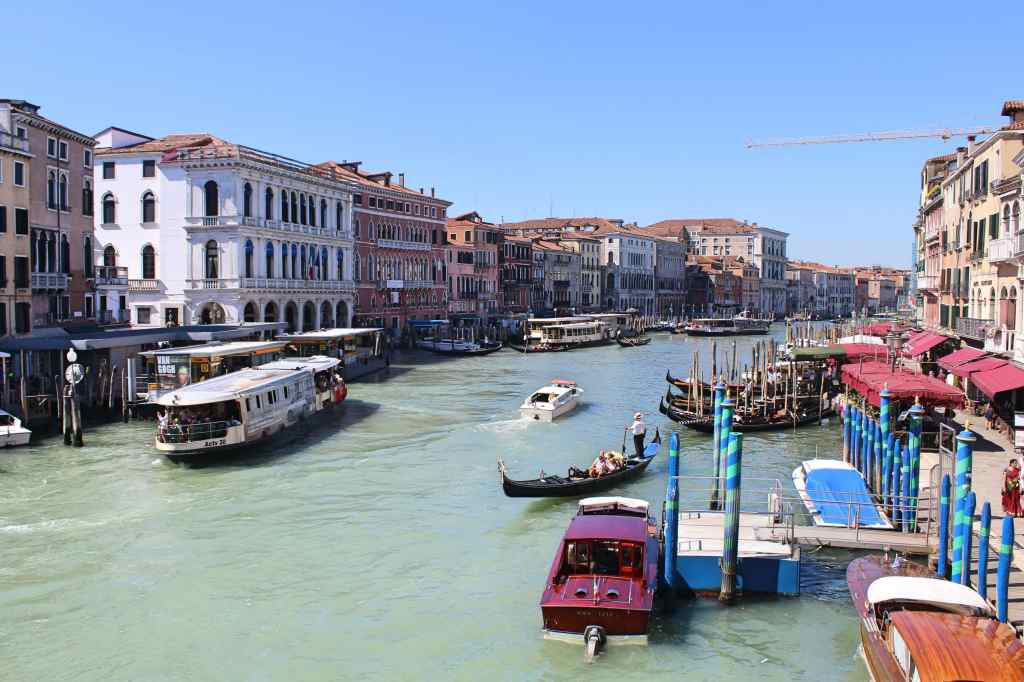
After crossing the bridge, and taking the obligatory photo, I continued making my way to the central square: the Piazza San Marco. This is easily the most famous area of the city. For the most part the plaza is dominated by long buildings composed of many levels of arcades. At the far end is St. Mark’s Cathedral (which I will describe later) and its marvelous campanile, or bell tower. At nearly 100 meters, this tower is the tallest structure in the old city, and quite attractive in spite of its simple form.

Not far off is the clocktower (Torre dell’Orogio), another of the city’s landmarks. Two bronze shepherds with hammers ring the bell on the top, while a winged lion (the symbol of St. Mark) holds an open book below them. (A statue of the Doge once accompanied these lions, but Napoleon had him removed.) Below the lion sits the Virgin and child; and twice a year (on Epiphany and Ascension) mechanical figures of the three wise men emerge from the adjacent door and make their bows as they pass. For the time it was created—during the Renaissance—this was an impressive engineering feat.

The face of the clock itself is also a marvel. The sun travels along the twenty-four hours of the day, against the background of the zodiac. In accordance with Ptolemaic astronomy, the earth sits right at the center of the clock, while the sun, moon, and stars rotate around it. Bad science aside, the clock’s combination of blue and gold is quite pleasing on the eyes.
If you are standing at the end of the square, with the clock tower to your left and the basilica directly ahead, you will see the space open up to your right. This is called the Piazzetta, and it leads directly to the sea. The view is framed by two columns topped with statues—one of St. Theodore (who was one of Venice’s patron saints) and the lion of St. Mark.
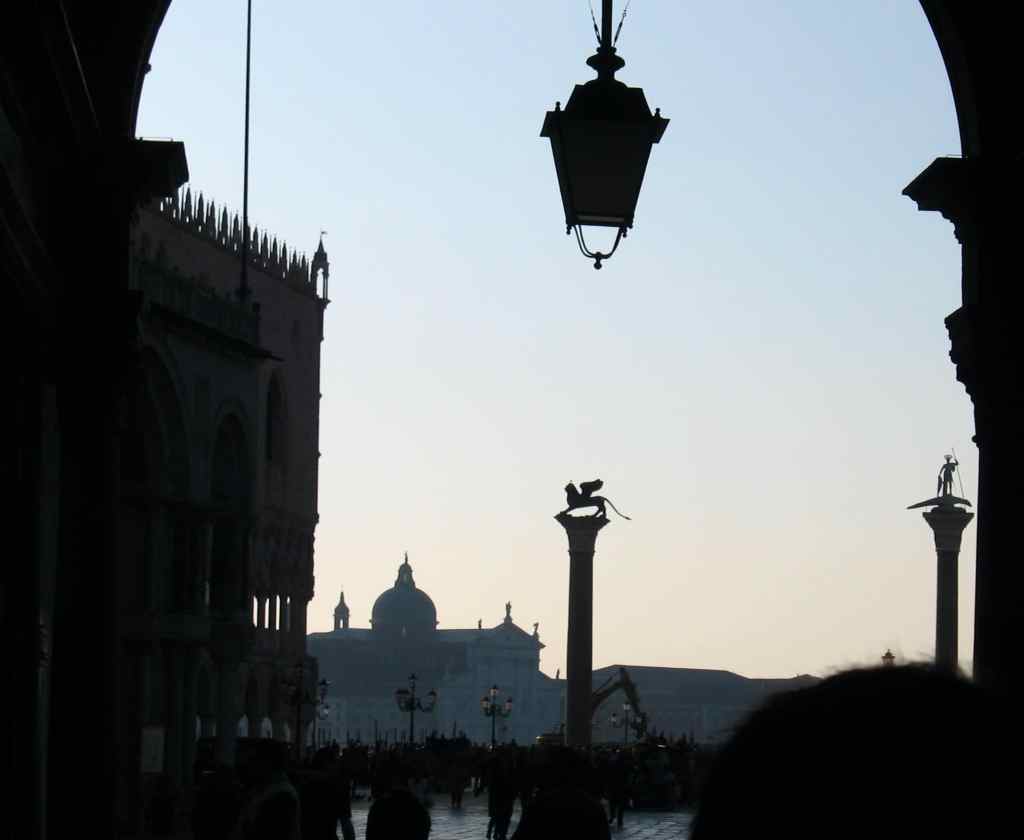
Proceeding forward, you arrive at yet another iconic area of the city, the Riva degli Schiavoni, a waterfront promenade. At almost any time of year (except during a pandemic) this place is extremely crowded. Gondolas bounce up and down in the waves, while people sell all sorts of knick knacks from stalls. The waters around this area are typically quite busy, with ferries going back and forth, as this is near one of the mouths of the Grand Canal. The view is characterized by the distant form of San Giorgio Maggiore, an enormous basilica that sits on an eponymous island across the waters. Its campanile looks quite like the San Marco’s, creating a pleasing symmetry.


Now the first major stop on our tour has arrived: the Doge’s Palace. If you are looking out at the water, this palace will be right behind you, though you may not have paid it much attention. In the context of Venice, the building’s exterior is not immediately eye-catching (though I will return to it later). But within is a palace of quite astonishing dimensions. I recommend going early, as there can be long lines to enter. I arrived at around ten in the morning and was basically able to walk right inside. The visit began with a small exhibition space, where I was delighted to find some drawings by John Ruskin. The famous art critic was also a talented draughtsman, and he made dozens of meticulous sketches of the city in preparation for his monumental book, The Stones of Venice. As I happened to be reading the book at the time, this seemed to bode well for my visit.

On display were also the forty-two original capitals of the stone pillars on the palace’s exterior. (Those there now are replacements.) Ruskin considered these capitals—which most of us overlook—to be the most significant artistic statement of the palace, and devoted much attention to their analysis. I will leave my own commentary for the end, and will instead embark now on the palace interior.
But before moving on, it is worth asking: What is a “doge”? This title, sometimes translated as “duke,” is unique to Venice. It is a cross between a king and a president: a ruler given royal prerogatives who was elected for life. The political organization of Venice was somewhat complicated, but suffice to say that it was an aristocracy with a touch of republicanism. The ruling class was basically hereditary; but they were divided into governing bodies—councils, parliaments, senates—and held elections (within their own ranks); and there were some checks on arbitrary power.
If the cases of Athens, Amsterdam, and England can be trusted, there seems to be some connection between a maritime, mercantile orientation and democratic forms of government. This is the case of the Republic of Venice as well, which rose to wealth and power through sea trade rather than conquest (though it was not averse to war). This, perhaps, is one reason why the city’s government—with its separation of powers and its checks on authority—developed the way it did. This also explains the moderate degree of intellectual freedom allowed in Venice, where the censors of the Catholic world could not reach. Venice also had a degree of religious autonomy, as its highest religious figure was the Patriarch of Venice, who himself was elected by the senate (from among its own ranks, of course).
From Venice’s beginnings in the 8th century, as a satellite of the Byzantine Empire, the city-state gradually rose in power and influence. It was a major staging ground during the crusades and profited enormously from trade with Asia along the Silk Road. By the Renaissance, the Republic had the wealth and the means to compete with the Ottomon Empire for control of the Mediterranean. But the “discovery” of America by Europe spelled the end of Venice’s high-point, as trade gradually shifted away from the Mediterranean to the Atlantic. Thus began a long, gradual period of decline which ended in 1797, when Napoleon conquered the city and formally ended the rule of the Doge. All told, the Republic of Venice survived some thousand years.
With this brief history lesson out of the way, let us see how this humble Doge lived. After passing the courtyard (enclosed on the far side by St. Mark’s Basilica), and ascending a flight of stairs, the visitor enters into a succession of brilliantly decorated rooms. The rooms are so ornate, in fact, that it even impressed my fifteen-year-old self. The second time around, I was stunned. Every ceiling is covered with carved engravings and panelling, and every wall is adorned with enormous paintings. Though the palace was built in the 14th century, and thus owes its form to the Venetian gothic, several fires required the interior rooms to be redecorated. Luckily, the great painter Tintoretto was on hand to provide much of the new decoration. The painters Veronese and Tiepolo, and the architect Andrea Palladio, also contributed; so there was no shortage of talent.

The palace contains some rooms that you would expect to find in any palace: luxuriant apartments for the ruler and antechambers where ambassadors could cool their heels. (Unfortunately, the Doge’s apartments were closed for renovation when I visited.) But there are also many sorts of rooms that you will not find in any other European palace. There is a Council Chamber, a Senate Chamber, a chamber for the Council of Ten, and rooms for the administration of justice. Judging from the size of the room’s alone, they were not built for a single ruler, but for hundreds. This did not stop them from decorating like kings.
There are simply too many rooms and too much decoration to enter into too much detail. I will let the photos do the talking:




One chamber does, however, stand out for special comment. This is the Grand Council Chamber, which is not only the biggest room in the palace, but one of the biggest rooms in all of Europe. It is simply massive: 1325 square meters (over 14,200 square feet!). The room had to be big because the Grand Council included all of the patrician males over age 25 into its ranks, which amounted to well over one thousand men. This may not sound inclusive to us, but for its day this was radical. One of this council’s tasks was the election of the Doge, who sat on the podium at the far end of the room. Behind this podium is one of the largest oil paintings in the world: El Paraiso, by Tintoretto (though largely executed by his son). The painting stretches over 25 meters and includes many dozens of figures. Ruskin thought that it was an artistic masterpiece, though I found its sheer size more impressive than its artistic quality.

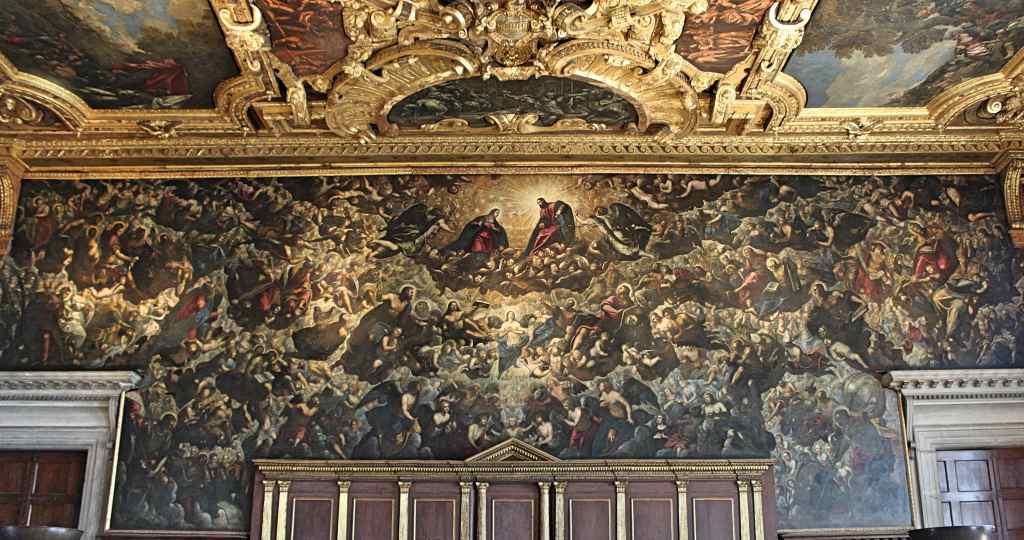
The other noteworthy aspect of the room are the portraits of the first 76 Doges running around the top of the room. These, too, were commissioned to Tintoretto, but were mostly done by his son (the painter was quite old at the time). Each of the Doges is present along with a scroll, on which are written their most important achievements. The one exception to this is Marino Faliero, a Doge who attempted a coup d’etat and was beheaded. In place of a portrait, there is a black cloth for this tratorious duke. History is not kind to the subverters of democracy. (Well, perhaps Julius Caesar is a partial exception to this. Napoleon as well, I suppose.)

After the grand tour of the regal rooms used by the Venetian government, I entered the prison. This dreary space has been known as the Pozzi (the wells) and the Piombi (lead), and it deserves both names, as it is a damp space with a leaden atmosphere. (You can tell that the Venetians were concerned with laws and their efficacy, since they built the major prison next to the center of government.) The “old” prison is connected to the “new” prison (built several hundred years apart) via the “Bridge of Sighs,” which was so known because it was the last place a prisoner could see a bit of sunlight and utter a weary sight before his long confinement. In 1756, the infamous Giacomo Casanova effected a daring escape from these prisons by climbing onto the roof.

Thus ended my tour. But before moving on, I ought finally to address the columns on the outside of the building. John Ruskin was extremely fond of the sculptures carved into the capitals of these columns, and devoted ample space to them in his book on Venice. Indeed, by common consent they are masterpieces of gothic sculpture. Inspired by Ruskin, I spent a good thirty minutes examining these columns in detail, and I was glad I did (even though, as mentioned before, the columns currently outside the palace are copies of the originals inside). They generally consist of figures interspersed within vegetable patterns, usually demonstrating some allegorical significance. Rather than launching on a giant Ruskinian rant myself, I will be content with a few photos:


Thus ended my tour of the Doge’s Palace. But I did not have time for a break. After all, St. Mark’s Basilica is right next door.

No monument in Venice better illustrates the city’s role as a conduit between the Catholic and Byzantine worlds. St. Mark’s embodies both influences. Neither wholly gothic nor wholly byzantine, the church is an alluring hybrid structure, unlike anything else in the world. At a first glance, the basilica (it is also a cathedral, though more commonly called a basilica) presented a chaotic forest of towers, domes, and semi-domes. It bears very little resemblance to the towering gothic spires that are so common elsewhere in Europe. Rather than awe the viewer with harmony or height, the basilica is profuse in details of decoration. Mosaic scenes from the life of Jesus—quite lovely in its bright colors and gold backgrounds—adorn the surface, while statues of saints stand guard above.

The most famous figures on the cathedral are the four bronze horses that adorn the roof, right above the entrance. They are Roman copies of Greek originals, supposedly designed by the famed Greek sculptor Lysippos (more probably they adorned a Roman triumphal arch). Certainly they are wonderful works of art. The reason they are here is because the Fourth Crusade went sour, and culminated in the sacking of Constantinople (a Christian city) by the Catholic forces. Napoleon had the horses taken to Paris in 1797, but they were eventually returned after his defeat, in 1815.
The other famous decorations are the tetrarchs. This is a rather odd and unsettling sculpture, made in the fourth century and, like the horses, taken from Constantiple during the Fourth Crusade. By the time this work was made, the Roman Empire was in disarray, and the Emperor Diocletian decided that he needed to divide power between three additional co-rulers in order to maintain order. This sculpture represents the co-dependence of these four rulers. But the four men do not seem like confident allies; rather, they seem scared out of their wits. Certainly it is not a work that inspires confidence—they clutch each other in fearful desperation. The sculpture is also remarkable for the degree of abstraction. The great Roman tradition of realistic sculpture (as epitomized by the horses) had already been lost by this time.

Saint Mark’s owes its name to a Venetian trick. According to the story, two wily Venetian merchants smuggled the saint’s body from Alexandria to Venice in the 9th century. (Supposedly, they covered the body with pork to prevent Muslims from investigating.) The story is extremely difficult to believe, if only because the body would have already been nine centuries old and unrecognizably decayed. However, standards of evidence were not very high in the Middle Ages; and in any case the city had much to gain by being the home of the evangelist’s relics. The story seemed doubly dubious when one considers that, according to legend, the saint’s relics could not be found when construction began on the basilica; Mark himself had to appear to direct the Venetians to his mortal remains.

Well, eternal resting place of St. Mark or not, the basilica is an immortal work of art. Entrance to St. Mark’s is free. All one has to do is stand in a long line and wait. Once inside, you will find yourself in a space quite unlike any other European cathedral. The floorplan is a Grecian rather than a Latin cross, meaning that the building is as wide as it is long. But St. Mark’s is not like a gothic cathedral, which impresses with its architectural majesty. Rather, basilica’s outstanding feature is its decoration. The overwhelming impression is of light, gold, and color. Every inch of the interior is covered in mosaics with gilded backgrounds. Unfortunately, many of these have been retouched or restored, most often with a definite loss in quality. Even so, the whole has a power greater than the sum of its parts—hypnotic in its use of color.

My next stop was the Scuola Grande di San Rocco. Even though this building is called a “school,” it is really the historical seat of a powerful religious confraternity. (A confraternity is essentially a private club that promotes a religious cause. San Rocco—”Saint Roch”—was a saint commonly invoked against the plague.) Though magnificent enough, the façade of this building does not attract attention in the context of Venice. But the inside is special indeed. As in the Doge’s Palace, there are several enormous rooms, all of them richly decorated. Unlike the Doge’s Palace, however, much of the decoration in the Scuola Grande was provided by one man: Tintoretto.
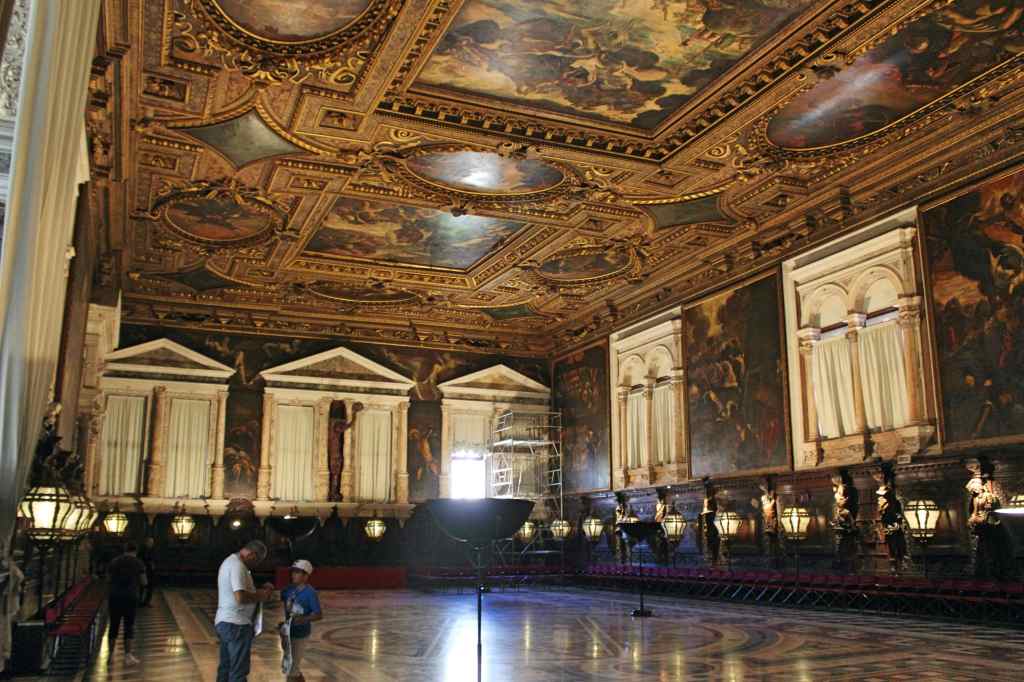
After Titian, Tintoretto is probably the most highly-regarded painter of the Venetian school. Nicknamed “il furioso” for the energy of his brushwork, he was known for working fast and rough. He was no perfectionist. By general consent, the quality of his work is highly uneven. But his style was very well-suited to the semi-darkness of these enormous rooms, where his figures could dazzle with their suggestiveness rather than their perfection of form. His paintings are notable for the drama and movement of their subject, rather than the typical Renaissance solidity and harmony. I would be lying if I ranked Tintoretto among my own personal favorites, though Ruskin was quite wildly fond of him. For me, the wooden carvings in the seats along the walls were, if anything, more charming than Tintoretto’s great pictorial spread. But I do admire his productivity.

After this I made my way to one of Venice’s many museums: the Gallerie dell’Accademia. This museum is the Venetian equivalent of the Uffizi in Florence: housing a massive collection of Italian art, from the medieval period to the 19th century. It is housed in another former confraternity building, this one the Scuola della Caritá. When I visited, parts of the museum were undergoing restorations, and so were unavailable. Even so, the museum has an impressive collection.
As usual, I was most captivated by the works of Hieronymous Bosch. There are three major works by this Dutch painter to be seen. One is the triptych The Hermit Saints, which shows three saints resisting temptation in the wilderness. In keeping with his typical, bizarre style, Bosch represents these temptations in a series of absurd little figures—monsters, skeletons, nun’s heads—that surround these simple, pious men. Another triptych is The Crucifixion of St. Julia, which shows us a bearded woman nailed to the cross. Christians explained the beard with a story about a woman who prayed to God to make her repulsive (and thus protect her virginity); but probably the historical reason involves images of Christ from Eastern Europe, in which Christ’s dress was misinterpreted by Westerners as being that of a woman.

My favorite work, however, is a series of four paintings called Visions of the Hereafter. Here, as usual, Bosch sets his vivid imagination to work picturing the world beyond our own. The most captivating of these images is the Ascent of the Blessed, which shows us the infinite white light that leads to paradise. To our modern eyes, the image cannot but remind us of some space exploration movie. We have used the same sort of image to represent portals to other dimensions or accelerations to speeds beyond light. Bosch proves himself, once again, to be one of the modern age’s visual godfathers.

The museum has works by Titian and Tintoretto, of course. But a more elusive Venetian painter is also on display: Giorgione. A few years older than Titian, Giorgione is normally regarded as one of the great innovators of Venetian painting. The trouble is that it has historically been difficult to definitively attribute works to him. Indeed, an air of mystery seems to surround Giorgione, which is apparent in his painting The Tempest. It shows a young woman suckling a baby, while a traveller looks on with a curious expression. In the background we can see an Italian village, while a storm rages overhead (thus the title).

The execution is quite beautiful indeed. Its meaning, however, is difficult to decipher. To my eye it looks like a depiction of the “rest on the flight from Egypt,” when the Virgin Mary escaped Egypt with the infant Jesus, and stopped to suckle him on the road. But the woman—almost completely naked, and staring rather boldly at the viewer—is unlike any other depicting of the Virgin. Contemporaries referred to her as a “gypsy” and the man as a “shepherd,” but art historians, straining for cohesion, have proposed obscure stories from classical mythology and fanciful allegorical meanings. Yet none of these interpretations sheds light on the particular power of this painting, in which the heavy and humid atmosphere of a storm, the grey, shadowy light through the clouds, is so palpable. I can see why it was Lord Byron’s favorite.
I cannot leave the museum without mentioning, if not the greatest, than the painter who did the most to show Venice to the world: Canaletto. This was not his real name, of course; he was called “little canal” because his paintings were so often focused on Venice’s many waterways. His paintings are consistently impressive, capturing the city with photographic accuracy. Personally I cannot fathom how much time it would take in order to create such a scrupulously detailed image. But in a world before photography, this was the only way that wealthy nobles could catch a glimpse of the city from afar. Canaletto was more than a mere technician of monumental patience, however. His paintings have a very charming, wistful emotion running through them, a kind of atmospheric joy. They are absorbing and refreshing works.
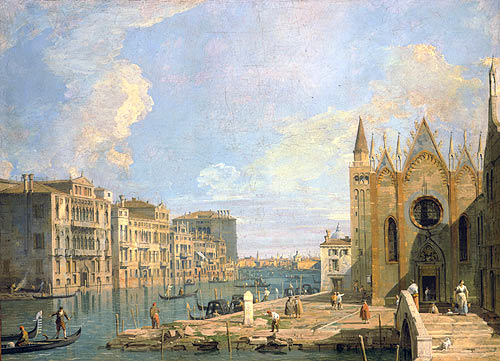
My next stop was another church: Santa Maria Gloriosa dei Frari (normally just called the “Frari”). After St. Mark’s itself, this is perhaps the most important church building in Venice. If you only saw the exterior, however, you would be excused for not thinking so. The basilica’s brick façade and relatively plain decoration do not make it stand out in the context of Venice. Nevertheless, it is certainly worth a visit. From the inside, the basilica looks like unlike any church building I have seen. It is an incongruous mixture of dark materials and open windows, of plain surfaces and rich decorations. The entire building does not come together as an organic whole; rather it seems like a warehouse for art and monuments. But it is a beautiful warehouse.
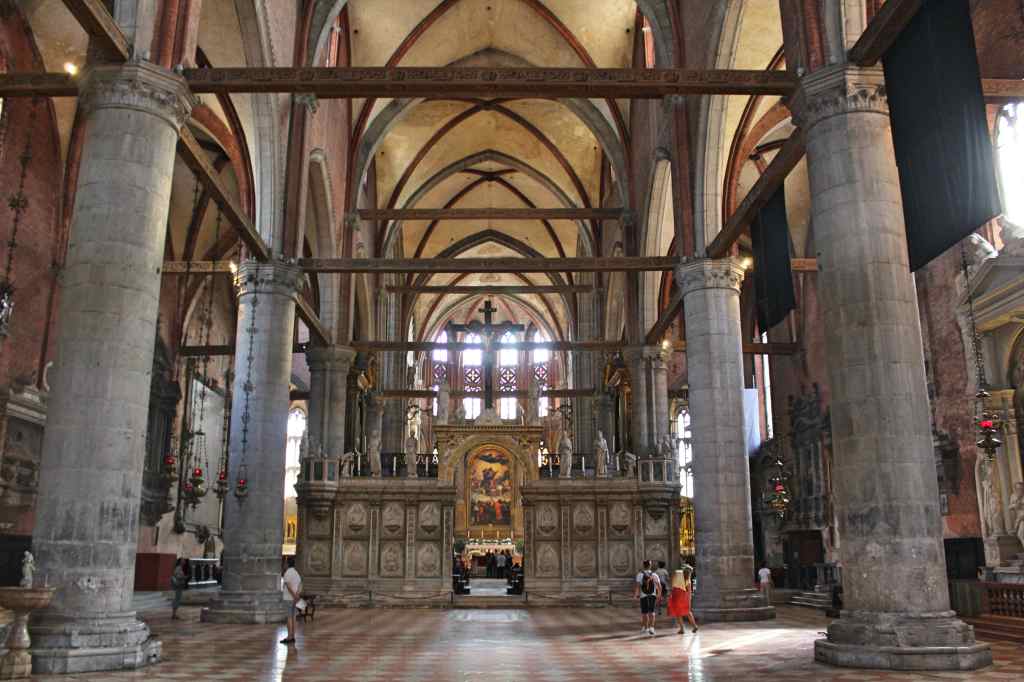
Among the artwork, the best may be the large-scale paintings by Titian. I found the Pesero Madonna especially beautiful for the shimmering effect of the brightly-colored robes. Titian is also responsible for the painting in the main altarpiece, a wonderful depiction of the Assumption of the Virgin. But what really caught my attention were the funerary monuments. The Frari is the resting place of many Doges, as well as some of the city’s most gifted artists. Titian himself is buried here, commemorated by an enormous marble sculpture by Antonio Canova—erected centuries after the artist’s death. Canova himself (arguably the greatest neoclassical sculptor) is buried here, in a stunning pyramidal cenotaph—my favorite work in the whole basilica. I also found myself captivated by the monument to the Doge Giovanni Pesaro (not the same Pesaro as in Titian’s painting). This gruesome monument features black skeletons emerging between African servants, who support the monument’s upper half. It is disturbing for many reasons.


It is worth mentioning another of Venice’s many basilicas, Santi Giovanni e Paolo. In appearance it is quite similar to the Frari, and it likewise is the final resting place of many Doges. However, I think the most impressive thing to see is not inside, but next to this old structure: the equestrian statue of Bartolomeo Colleoni. This was done by Andrea del Verrochio, most famous for being Leonardo da Vinci’s mentor. But he was a great artist in his own right, as this sculpture proves. It is really a marvelous work: the horse is rippling with muscle, and confidently striding forward. The condottiero is both heroic and ruthless: his face is ugly and yet compelling, and his pose one of unquestionable command. It is one of the finest depictions of a military leader.

After all of this glorious art and all of these magnificent monuments, my last stop is rather depressing: the Venetian Ghetto. This is the neighborhood where Jews were forced to live for hundreds of years. In fact, the word “ghetto” itself comes from this area of Venice. The derivation of the word remains rather difficult to pin down. It may come from a German word for street (many of the Venetian Jews spoke a German dialect), or a diminutive form of an Italian word (“borghetto,” or little town), or perhaps from a Hebrew word. We visited the Venetian Ghetto on my school trip, back in 2007; and I still remember our guide explaining that the buildings were taller in this area because the Jews did not have room to build anywhere else.
The Venetian Ghetto is split into two sections, the Ghetto Nuovo and the Ghetto Vecchio (the “new” and “old” ghettos), though this classification refers to when the area was used as foundries, not as a place of Jewish residence. (Indeed, one hypothesis for the word “ghetto” is that it comes from the Italian “getto,” which means to pour molten metal into a mold. Many foundries existed in this area.) Two bridges connect this part of Venice to the surrounding area; and Jews had to be sure to return to the ghetto before the nightly curfew, or face a stiff fine.

Even in my brief time walking through the ghetto, I noticed that there was still a significant Jewish presence here. There are several synagogues, cultural centers, and even a kosher restaurant. There is also several monument to the victims of the holocaust. Fortunately, the Jewish community largely escaped Nazi percesution in Venice, and this was thanks to the heroism of Giuseppe Jona. Jona was a Jewish physician who, like many Jews, was deprived of his profession during the Nazi occupation. He took it upon himself to stay in Venice and to help organize the Venetian Jewish community. In 1943 the Nazis ordered him to help them locate the Jews in the city. Instead of cooperating, Jona burned every document in his possession that could be used, and took his own life. He is memorialized in the Venetian Ghetto, and certainly deserves it.

As I walked through this distinct corner of the city—so strangely marked by tragedy and hope—I reflected on the long history of anti-Semitism in Europe. The Nazis were merely the last and worst in a long line of Jew-haters. Even great works of art are marred by this sentiment. The most obvious example of this is, perhaps, Shakespeare’s The Merchant of Venice, which reflects many of the worst stereotypes of Jews. (Because Shylock is so compelling a character, some have argued that the play is not actually anti-semitic; however, I think the work is incoherent if you consider Shylock the real hero rather than, as I believe Shakespeare intended, the villain.) It is depressing to think that even a man with as free a mind as Shakespeare’s could not entirely escape prejudice. But prejudice runs very deep. The ramshackle buildings of the Venetian Ghetto are a testimony to this lasting hatred and also to the community’s lasting resilience.
This does it for my return to Venice. But listing the monuments does not do justice to the real experience of visiting the city. Venice is one gigantic work of art. Virtually every angle of the old city is picturesque—from the impressive works of architecture to the forgotten corners of run-down buildings. Venice is palpably an abandoned city, a floating relic, which gives it a kind of romantic charm. But the city is also refreshing—for the ocean breeze that blows through it, for the ever-present sight of water. Admittedly, for all of its beauty, Venice does lack the most charming part of any city: street-life. I cannot say it is my favorite European destination. Even so, the memories Venice evokes—of awkward pubescence, of my first window into a wider world—will always make the city special for me.
Before my flight home, I found a café and sat outside sipping grappa, the strong Italian brandy. I have to admit that I actually had no idea what grappa was. I thought it was some sort of wine, and I winced when I took my first taste (I normally do not drink liquor). Even so, sitting outside in the sunshine, sipping on this flaming beverage, I could not help but feel rather satisfied with the way that my life had turned out. When I visited Venice in 2007, I could never have guessed that I would be living in Europe ten years later.
If you know anything about Venice, you will know that this post has left out virtually everything beyond the city center itself. There are many smaller islands that are also worth visiting. But that will have to wait for another post.
Loved reading about Venice. beautifully written. Thanks.
LikeLiked by 1 person
Thank you!
LikeLike